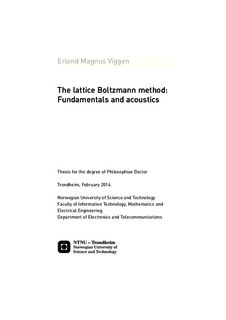| dc.contributor.author | Viggen, Erlend Magnus | nb_NO |
| dc.date.accessioned | 2014-12-19T13:49:02Z | |
| dc.date.accessioned | 2015-12-22T11:48:56Z | |
| dc.date.available | 2014-12-19T13:49:02Z | |
| dc.date.available | 2015-12-22T11:48:56Z | |
| dc.date.created | 2014-02-18 | nb_NO |
| dc.date.issued | 2014 | nb_NO |
| dc.identifier | 697490 | nb_NO |
| dc.identifier.isbn | 978-82-326-0036-6 (printed ver.) | nb_NO |
| dc.identifier.isbn | 978-82-326-0037-3 (electronic ver.) | |
| dc.identifier.uri | http://hdl.handle.net/11250/2370925 | |
| dc.description.abstract | The lattice Boltzmann method has been widely used as a solver for incompressible flow, though it is not restricted to this application. More generally, it can be used as a compressible Navier-Stokes solver, albeit with a restriction that the Mach number is low. While that restriction may seem strict, it does not hinder the application of the method to the simulation of sound waves, for which the Mach numbers are generally very low. Even sound waves with strong nonlinear effects can be captured well. Despite this, the method has not been as widely used for problems where acoustic phenomena are involved as it has been for incompressible problems.
The research presented this thesis goes into three different aspects of lattice Boltzmann acoustics. Firstly, linearisation analyses are used to derive and compare the sound propagation properties of the lattice Boltzmann equation and comparable fluid models for both free and forced waves. The propagation properties of the fully discrete lattice Boltzmann equation are shown to converge at second order towards those of the discrete-velocity Boltzmann equation, which itself predicts the same lowest-order absorption but different dispersion to the other fluid models.
Secondly, it is shown how multipole sound sources can be created mesoscopically by adding a particle source term to the Boltzmann equation. This method is straightforwardly extended to the lattice Boltzmann method by discretisation. The results of lattice Boltzmann simulations of monopole, dipole, and quadrupole point sources are shown to agree very well with the combined predictions of this multipole method and the linearisation analysis. The exception to this agreement is the immediate vicinity of the point source, where the singularity in the analytical solution cannot be reproduced numerically.
Thirdly, an extended lattice Boltzmann model is described. This model alters the equilibrium distribution to reproduce variable equations of state while remaining simple to implement and efficient to run. To compensate for an unphysical bulk viscosity, the extended model contains a bulk viscosity correction term. It is shown that all equilibrium distributions that allow variable equations of state must be identical for the one-dimensional D1Q3 velocity set. Using such a D1Q3 velocity set and an isentropic equation of state, both mechanisms of nonlinear acoustics are captured successfully in a simulation, improving on previous isothermal simulations where only one mechanism could be captured. In addition, the effect of molecular relaxation on sound propagation is simulated using a model equation of state. Though the particular implementation used is not completely stable, the results agree well with theory. | nb_NO |
| dc.language | eng | nb_NO |
| dc.publisher | Norges teknisk-naturvitenskapelige universitet, Fakultet for informasjonsteknologi, matematikk og elektroteknikk, Institutt for elektronikk og telekommunikasjon | nb_NO |
| dc.relation.ispartofseries | Doktoravhandlinger ved NTNU, 1503-8181; 2014:55 | nb_NO |
| dc.title | The lattice Boltzmann method: Fundamentals and acoustics | nb_NO |
| dc.type | Doctoral thesis | nb_NO |
| dc.contributor.department | Norges teknisk-naturvitenskapelige universitet, Fakultet for informasjonsteknologi, matematikk og elektroteknikk, Institutt for elektronikk og telekommunikasjon | nb_NO |
| dc.description.degree | PhD i elektronikk og telekommunikasjon | nb_NO |
| dc.description.degree | PhD in Electronics and Telecommunication | |
